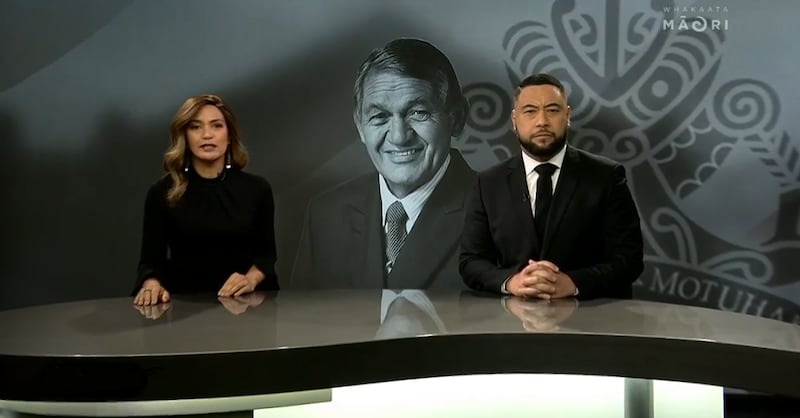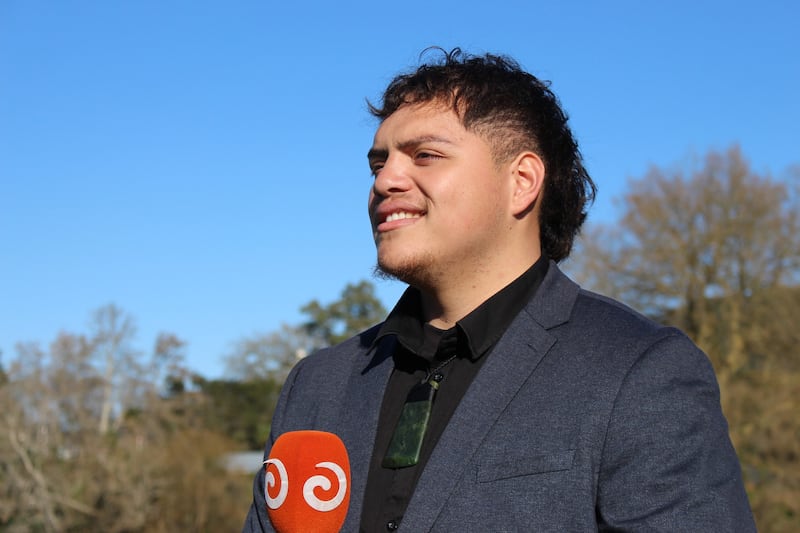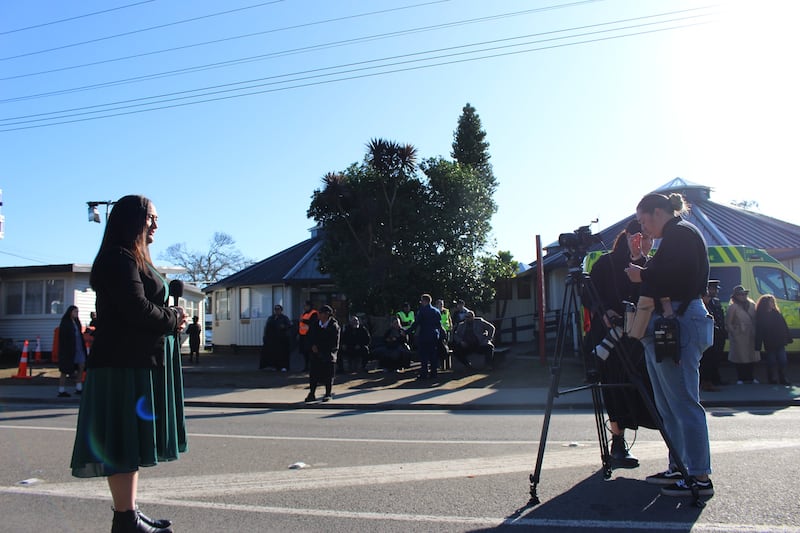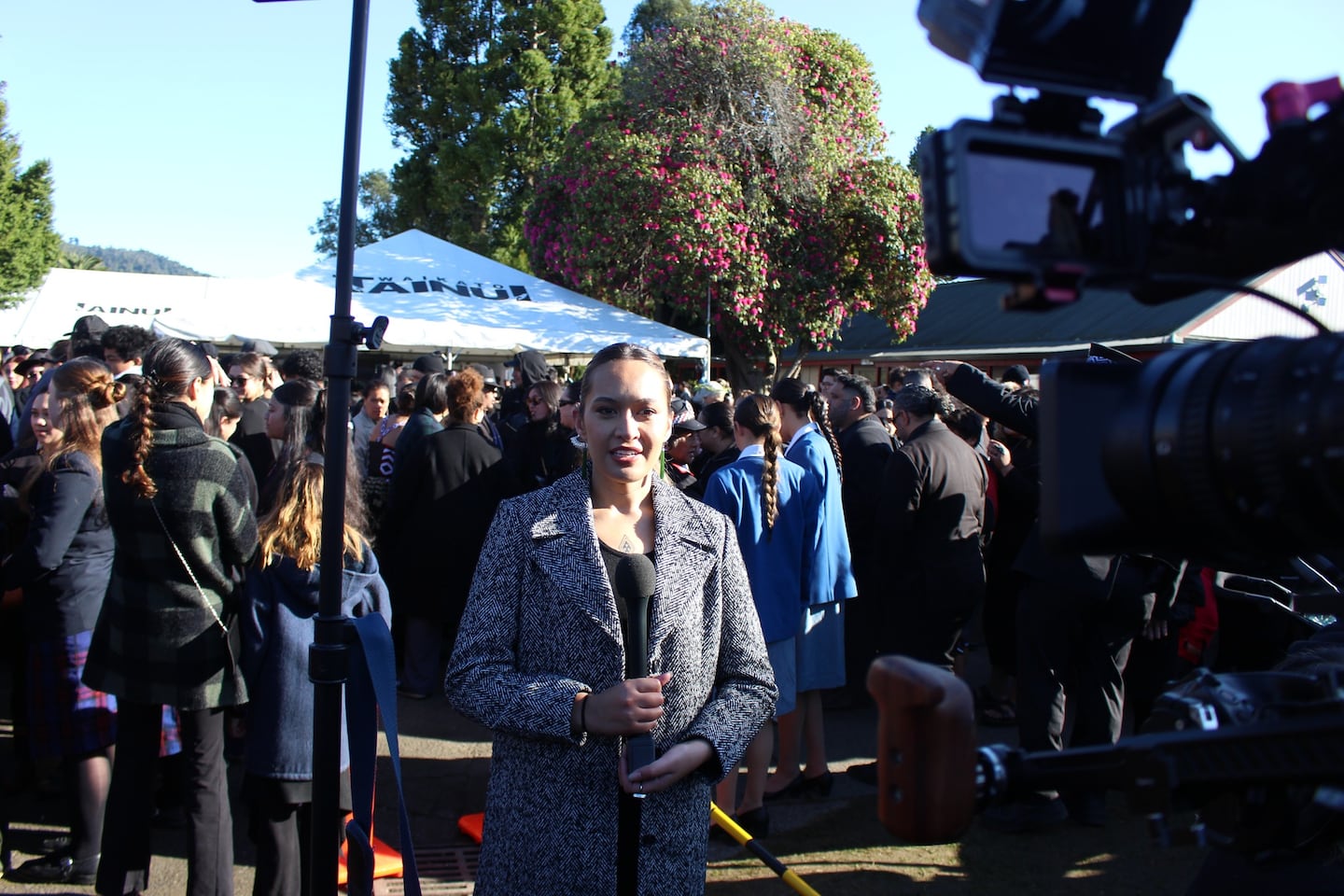Of recent years Kiingi Tuheitia became known as the ‘king of unity’ with his determined drive for kotahitanga involving rangatahi.
So last week, through his tangihanga and the accession of his successor, a unique first took shape as the largest group of Māori broadcasters to ever work together collaborated with iwi in honouring his “wairua wind”.
Every day during the week-long tangihanga, news and radio teams from many Māori media outlets worked together to broadcast live news breakout shows on Whakaata Māori, online and on social media, showing what was happening on the ground at Tūrangawaewae Marae.
On the final day, Thursday, September 5, an official outside broadcast aired on Whakaata Māori and TVNZ presented by reporters from a variety of Māori media outlets covering the nehu (burial) of Kiingi Tuheitia and the whakawahinga (coronation) of Te Arikinui Kuini Nga wai hono i te po Pootatau Te Wherowhero te Tuawaru.
Aukaha executive producer Roihana Nuri led the news breakout shows throughout the week, with the inclusion and support of kaimahi from news and iwi radio outlets; Te Ao Maōri News, Te Ao with Moana, The Hui, Te Karere, TVNZ, Aukaha News, Tahu News, Tainui Live, Waatea Radio, Nga Iwi FM, Maniapoto FM and Te Reo o Te Uru. The shows aired live on Facebook and attracted audiences of many thousands from around the country and Australia.
“The highlight was seeing the collaboration of all Māori news and current affairs programmes coming together and having some real old hands and young up-and-coming journos in the mix,” Nuri said. “We were all there for the one kaupapa which was to poroporoaki Kiingi Tuheitia.”
“This is the beginning of what reshaping Māori news media and working together is. We all talk collaboration - this is actual collaboration and action and is about succession because the oldies, like me, we’re not going to be here forever, and we need to start getting our rangatahi in the mix. We need to start to be able to share the knowledge, share the skills, the tricks of the trade.”

On day one, six reporters presented the news breakouts but that quickly increased later in the week as more regional and national news services freed up their resources to join the collaboration.
“On the final uhunga day, I think we had 13 reporters and presenters in the mix of that two hour pre-show before the big broadcast started,” Nuri recalled. “All of the reporters and presenters had kaupapa to talk about; parking, roadblocks, mahi ringawera, hauora stuff. It’s a lot of information to give to the tens of thousands going to descend on Tūrangawaewae.”
The news breakouts were presented by Peata Melbourne and Tumamao Harawira in the Whakaata Māori studio. They crossed live to reporters at Tūrangawaewae including Riria Dalton-Reedy, Michael Cugley, Kereama Wright, Moana Maniapoto, Matai Smith, Shakayla Andrews-Alapaki, Regan Paranihi, Aroha Broughton, Te Kawa Paora, Herewini Waikato, Kawe Roes, Te Okiwa Mclean and Timoti Tiakiwai.

Working behind the scenes were more than 50 kaimahi (staff) including studio operators, producers, engineers, editors, camera operators, journalists and digital content creators from across the Māori media sector.
“There are so many moving pieces,” Nuri said “I was really extremely proud of every single individual who participated in our news breakouts over the seven days of Kiingi Tuheitia’s tangihanga.”
Te Ao with Moana journalist Te Rina Kowhai jumped in to help manage the operational grunt across the broadcast as line-up producer, pulling on her vast experience both technically and editorially.
Although it was a sad occasion, the Kiingitanga, for Kowhai, brought kotahitanga for the Māori media sector.
“For me unity, reo me ona tikanga, has always driven me and the kaupapa in this industry,” Kowhai said.
She also reflected on veteran Māori broadcasters, who had mentored her such as the late Whai Ngata, Hone Edwards, Miki Apiti, and especially the late Derek Wooster who had directed Te Arikinui Te Atarangikaahu’s tangihanga.
“Derek would tell me all the stories, the fond memories, the technical logistics of how they covered the late Te Arikinui Te Atarangikaahu tangi and now I have my own stories to tell. We’ve made history through this Māori media sector collaboration and I feel optimistic for our rangatahi coming into this space. It’s been a huge privilege.”

Strong advocate for rangatahi
With Kiingi Tuheitia such a strong advocate for rangatahi, producers wanted to prioritise the rangatahi voice in the news breakouts. Many of the young reporters were paired up with senior reporters to help produce their live crosses.
“We’ve got these amazing senior journos and presenters in the mix but it was about bringing the rangatahi in there on a sad occasion but quite a historical moment.
“We have a new queen, nearly a rangatahi queen, Kuini Nga Wai hono i te po. So a lot of things said to me, in terms of my experience, we needed to get as many of our rangatahi from all of our programmes into this.”
Shakayla Andrews-Alapaki from Tahu News said she felt “really honoured to be here because nō Te Wai Pounamu ahau (I’m from the South Island). I’ve travelled all this way to be a kairipoata (reporter) and it’s the biggest kaupapa in my lifetime so far as a Māori. So, nōku te hōnore ki te tae mai ki kōnei ki te whakanui tō tātou nei kiingi (I’m honoured to be here to celebrate our king).”
Te Reo o Te Uru reporter Regan Paranihi said, “Mōku ake, he mea nui i te mea ko ia te Kiingi. Ko ia te Kiingi mō ngāi tātou te iwi Māori. Nā reira, i runga i tērā āhuatanga, nōku anō te maringa nui kia whai wāhi ki tēnei kaupapa i runga anō i te kotahitanga o te noho me te ao pāpāho Māori. Koira tāna i whai nei i roto i tēnei tau tata nei, ko te kotahitanga me te kite i te kotahitanga i roto i te ao pāpāho Māori. Koirā pea te ōhākī i waiho e ia mō mātou. Nō reira nōku te maringa nui, ka mutu, ka mahara ake au i tēnei wā mo te roanga o tōku oranga.”
“For me personally, it’s significant because he’s the king. He is our Māori king. So, because of that, I feel fortunate to be a part of this event, and to be a part of this united effort by the Māori broadcasting industry. That’s what he was striving for over the last year or so, it was unity, and now we’re seeing unity in the Māori media. Perhaps that is the legacy he has left us. So, I feel very fortunate, and I will remember this time for the rest of my life.”
Waikato-Tainui communications and engagement manager Jason Ake said he heard the phrase ‘Ko koe te kiingi o kotahitanga, ko koe te kiingi o te rangatahi (You are the king of unity, You are the king of the youth)’ said by speakers on the ātea during the pōwhiri.
“So what we did see is absolutely those two things in full force. We got to see Māori media organisations collaborate, kotahitanga, and we also got to have a significant part of that reflected in the rangatahi voice as well. So I think we achieved absolutely what he was known for and what he was being recognised for in that space. So well done.”
‘Iwi-led and media-supported’
On the final day, thousands from across Aotearoa and the world tuned into the official broadcast led by the Kiingitanga, aired live on Whakaata Māori and TVNZ of the historic coronation of Kuini Nga Wai hono i te po and the nehu of Kiingi Tuheitia.
Experienced journalists presented the show including Julian Wilcox, Stacey Morrison, Tom Roa, Mihingarangi Forbes, Tini Molyneux, Scotty Morrison, John Campbell, Oriini Kaipara, Matai Smith, Te Arahi Maipi and Maiki Sherman.
In a social media post, Kaipara said, “May this new wave of solidarity continue to grow alongside our inherent right to mana motuhake. May it strengthen us all as a collective in a turbulent industry. May us oldies and not-so-oldies hear, see, value and nurture our awesome rangatahi to become their best selves and let them lead the way from time to time”.
Whakaata Māori news and current affairs director Blake Ihimaera said the official broadcast was “iwi-led and media supported”.
“For me personally, I’ve always been a big believer in iwi and the power of iwi and watching the Kiingitanga, Waikato-Tainui waka in action was amazing to witness,” she said.
“That official broadcast, being made by the Kiingitanga and taken by all of the stations, was another collaboration; one emphasising that iwi are in control of their narrative. It’s their kaupapa but we can support it and make it amazing.”
Collaboration with iwi radio
Another highlight was the inclusion of iwi radio outlets including Tainui Live, Waatea Radio, Nga Iwi FM, Maniapoto FM and Te Reo o Te Uru.
As well as having radio journalists on the ground at Tūrangawaewae, Te Reo o Te Uru executive producer and Te Korimako o Taranaki station manager Tipene O’Brien travelled to Whakaata Māori in Auckland during the week to watch and learn the process of delivering a broadcast from behind the scenes in the studio.
“That was a big eye-opener for us. The overall goal for us is to be able to take those ideas and implement them at a regional level. Obviously, the difference is that we don’t have the big budgets and we don’t have the human resources that they do, but I think, if we understand the concepts of how they do it, we can figure out how to adapt it and customise to our needs and wants.”
Before each newsbreak ended, presenters handed over the audience to the Kiingitanga Facebook page to continue to watch the live coverage of each pōwhiri at Tuurangawaewae.
Ake said, “It was really exciting for us because at one point there we handed over an audience of between 120,000 and 130,000 viewers straight into the Kiingitanga page, so it wasn’t starting off cold and it gave good context leading into it every morning and afternoon.”
Ake said it was important for national and regional news to continue to collaborate because “a lot of regionally significant stories would otherwise be lost on a national platform.”
“Sometimes those stories have equal weight back home. It’s great listening to some of the nationally focused news that takes place but, equally, I think the focus for regional stories, there is a hunger for them and the landscape is moving very, very quickly in that regard,” Ake said.
He said linear broadcasting would probably be dead or defunct within the next five years so news outlets needed to create content where “our people are either listening or watching”.
“We can’t carry on delivering content on platforms where our people actually have a [lower] consumption rate. We need to go to them and we know more and more they are consuming stuff digitally and online and TVNZ and Whakaata Māori have recognised that.”
The future is collaboration
Ihimaera said now that Māori media had collaborated on “the biggest kaupapa of our lifetime”, she expected it to continue to happen.
“We’ve set a foundation for that to happen further. The future is collaboration and so, whatever kaupapa it might be, we probably will be using all of our our partners because it’s only right.”
Ihimaera said Whakaata Māori and Te Ao Māori News would work to collaborate with other Māori media during Te Matatini next year.
O’Brien said Te Reo o Te Uru would “certainly be contributing in a big way” to produce content in collaboration with other outlets during Te Matatini.
“It’s a messaging that’s coming clear from Te Māngai Pāho that we need to look at collaborating and working together.”
Te Māngai Pāho is the government-funded agency that provides funding for media and content to promote Māori language and culture. Whakaata Māori is also government-funded but is expected to receive a $10.3m funding decrease over the next two financial years.
“We made history - we are right now being supported by the government [but] they could support a lot more,” Nuri said.
“I feel we just demonstrated and showed the power of kotahitanga within Māori media. I think the government will be willing to have a conversation about how we create an innovative digital future for us.”
This week Whakaata Māori and Te Ao Māori News have already collaborated with the Ngā Manu Kōrero to bring a livestream of its pōwhiri online.


